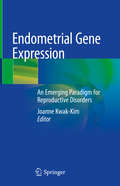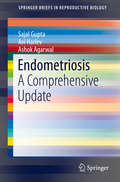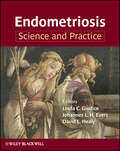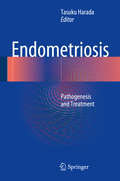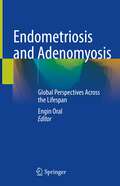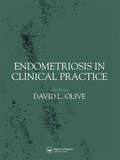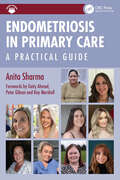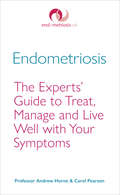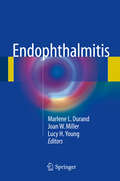- Table View
- List View
Endometrial Cytology with Tissue Correlations
by John A. Maksem Stanley J. Robboy Isabelle Meiers John W. BishopAs compared with cytology's use in other organ systems, direct cytological examination of the endometrium is not a widely practiced diagnostic procedure. This is an anomaly, because the endometrium is exceedingly available for cytological sampling, cytological sampling is comparably simple to perform, and, from the patient's perspective, it is a gentle procedure as compared to other methods of specimen attainment. Over the years, as we personally gained more and more experience with specimen acquisition, processing and interpretation, we have come to look upon endometrial cytology as an effective method for ensuring endometrial normalcy and discovering and diagnosing malignant and premalignant states. In comparing endometrial cytology to endometrial biopsy, we have found that, in samples obtained by individuals experienced in specimen collection, cytology outperforms outpatient biopsy with regard to the patient's tolerance of the procedure, adequacy of sampling among postmenopausal women, and detection of occult neoplasms. By devising a highly effective technical strategy to ensure the simultaneous creation of cell blocks and cytological samples from a single collection (that is detailed in the technical appendix of this work), we have moved endometrial brush collection into an arena of significance equaling--indeed exceeding--other methods of specimen collection and interpretation. Cytology, even in the absence of cell blocks, performs equally as well as biopsy in detecting outspoken hyperplasia or carcinoma. If nothing else, by reliably identifying benign, normal endometrial states, it serves to exclude more than 70% of women from unnecessary follow up testing with a high degree of confidence. Because brush sampling of the endometrium is limited to a depth of 1.5 to 2 mm, the method is not definitive for the detection of endometrial polyps, fibroids, stromal tumors, or tumors of the uterine wall musculature. However, endometrial cytology is useful for detecting benign estrogen-excess states such as disordered proliferation and various degrees of benign hyperplasia, for separating these states from frankly neoplastic states such as EIN and cancer, but not for subclassifying benign hyperplastic states in the absence of cell block preparations. When endometrial brushing with liquid fixation is used in conjunction with other techniques such as immunohistochemistry, concomitant biopsy or, more practically, hysteroscopy or sonohysterography, endometrial benignancy can be assured with a very high level of confidence (> 99%); indeed, manufacturing concomitant cell blocks of endometrial tissue fragments and using immunohistochemistry in selected cases significantly enhances the diagnostic specificity of the technique. In a woman with a patent cervix, endometrial brushing successfully collects material, even from late postmenopausal atrophic endometrium. It allows for the detection of serious diseases such as endometrial intraepithelial carcinoma under conditions where suction biopsy might miss or otherwise obviate the diagnosis. This work focuses on the background, collection technique, and reliability of endometrial cytology; it then overviews diagnostic criteria and diagnostic pitfalls encountered in the day-to-day practice of the art. Since endometrial cytology interpretation relies on intuiting tissue patterns from cytology preparations, a great deal of time is spent on cytohistological correlations and, where effective as part of a diagnostic strategy, on ancillary immunohistochemical staining. The discussion moves from normal states of the endometrium, through otherwise benign changes induced by an altered hormonal milieu or surface irritants, into neoplastic premalignant and malignant endometrial conditions. Finally, fixative and slide preparation techniques, that we deem as expeditious while serving to get the most information out of an endometrial cytology collection, are discussed in detail for the benefit of those who wish to recapitulate our work in their own practice.
Endometrial Gene Expression: An Emerging Paradigm for Reproductive Disorders
by Joanne Kwak-KimThe endometrium goes through cyclical changes under the influence of hormones, and immune effectors in the endometrium change their populations cyclically as well. Dynamic changes in immune effectors determine endometrial cytokine and chemokine milieus and, consequently, the endometrial immune response. Endometrial immune responses have been shown to be important for trophoblast invasion and early pregnancy. Indeed, dysregulated endometrial inflammatory immune responses are associated with reproductive failures, such as recurrent pregnancy losses, repeated implantation failure, and gynecological diseases with oncogenic potential. Hence, the investigation of endometrial gene expression may predict infertility, gynecological and oncological conditions. This book presents the state of the art in endometrial gene expression as well as recent developmental findings relating to reproduction and reproductive disorders. It begins with a review of the genetic regulation of urogenital tract formation and molecular mechanism underlying the physiology of menstrual cycle before moving on to the current and emerging technological advances in molecular biology. Endometrial gene expressions of immune inflammatory conditions, viral infection, metabolic and nutritional conditions, and reproductive disorders are then presented in following chapters. Examples of the use and interpretation of gene expression in clinical scenarios including recurrent pregnancy losses, infertility and multiple implantation failures are presented with currently available endometrial gene analysis.Utilizing the latest evidence and clinical guidelines, Endometrial Gene Expression will be a cutting-edge resource for gynecologist, reproductive immunologist, reproductive endocrinologists, obstetrician, maternal fetal medicine specialist and other health care providers in the field of reproductive medicine.
Endometrial Stem Cells and Its Potential Applications
by Indumathi SomasundaramStem cells have ushered in widespread interest and exciting possibilities for cell based therapies. Despite multiple initiatives and meticulous untiring efforts, translating this bench side research into bedside practice and therapies remains a challenge. A better understanding of expanding research in specific areas of stem cells is crucial in developing regenerative medical therapeutics. With their unique attributes, studies on stem cells of endometrium and its therapeutic applications at both in-vitro and at pre-clinical settings in health and disease states are gaining consensus in recent years. This SpringerBrief provides a thorough but succinct presentation of solid information about the significance of stem cells from the endometrium, the inner lining of the uterus. It presents an understanding of stem cells derived from human endometrium and examine how cells from these sources are being used to research and therapeutics for various clinical problems and diseases. In addition, brief also discusses the threats and challenges facing endometrium. Overall, it illuminates the hope that, the stem cells of endometrium can be an effective source of therapeutics for a multitude of disorders.
Endometriosis
by Ashok Agarwal Sajal Gupta Avi HarlevThis SpringerBrief provides an update on endometriosis research -- from the underlying mechanisms, predisposing factors, role of environmental pollutants, treatment options, impact on quality of life, and biomarkers, to emerging treatment modalities in order to help clinicians to pursue a patient-centered approach in managing the disease. This book provides clinicians with a better insight into early diagnosis and management of endometriosis. It explores the possible identification of proteins in different types of endometriosis diseases and at different stages of the progression. This may aid in the discovery of potential biomarkers for non-invasive diagnosis of these diseases. The ability to identify a protein, common between women of different races, ages and in different regions of the world will hopefully contribute to improving women's health worldwide.
Endometriosis
by Kevin Jones Christopher SuttonEndometriosis affects a huge number of women throughout the world. It has been estimated that between 1% and 15% of women who are examined for pelvic pain and infertility may have endometriosis; the true prevalence is unknown because diagnosis can only be made with any accuracy by laparoscopic examination of the pelvis. This book provides clinicians with all the information they need in a succinct and clear text, with colour illustrations. Chapters cover: epidemiology and aetiology; diagnosis; investigation; medical treatment; and surgical treatment.
Endometriosis
by Johannes L. Evers Linda C. Giudice David L. HealyWritten by an internationally well-known editor team, Endometriosis: Science and Practice is a state-of-the-art guide to this surprisingly common disease. While no cause for endometriosis has been determined, information of recent developments are outlined in this text, offering insight to improve management of symptoms medically or surgically. The first of its kind, this major textbook integrates scientific and clinical understanding of this painful disease helping to provide better patient care.
Endometriosis
by Tasuku HaradaEndometriosis is one of the most common gynecological diseases, causing pelvic pain, infertility, and cancer. The condition reduces the quality of life for the estimated 10% of menstruating women who are affected by it. This book provides a clear insight into the pathogenesis and pathophysiology of endometriosis--essential information for clinicians intending to successfully treat the condition. The first part covers a range of topics including stem cells, NK cells, macrophages, inflammation, cytokines, epigenetics, prostaglandin, sex steroids, aromatase, apoptosis, nerve fibers, and malignant transformation to aid in understanding the pathogenesis and pathophysiology of the disease. The second part provides useful tools for therapy, specifically, notable recent techniques in prevention, imaging, biomarkers, medical treatments, surgical treatments, prevention of recurrence, and infertility treatments. Each chapter was written by an expert in the field, with nearly 40 researchers and clinicians contributing to the work. This book will be highly useful to clinicians as well as to research scientists who are interested in this enigmatic disease.
Endometriosis Pathogenesis, Clinical Impact and Management: Volume 9: Frontiers in Gynecological Endocrinology (ISGE Series)
by Andrea R. Genazzani Felice Petraglia Michelle Nisolle Robert N. TaylorThis volume focuses on endometriosis from its pathogenesis and the importance of the early diagnosis to treatment, throughout all aspects of femininity that this disease affects, impacting health and quality of life.It also covers treatment strategies for the pain and for the disease management according to the age and needs of the patient, from adolescence to menopause, passing through the fertile age and the consequences that this disease can have on fertility and pregnancy. This book is a useful, clear and up-to-date tool for gynecologists, gynecological surgeons, reproductive medicine and general practitioners and is an important source of information to face this more and more frequent and devastating disease.
Endometriosis and Adenomyosis: Global Perspectives Across the Lifespan
by Engin OralAlthough endometriosis and adenomyosis are often assessed under the same umbrella, the epidemiology, clinical manifestations and management strategies of endometriosis and adenomyosis occur differently during the life cycle of a woman. Endometriosis can be diagnosed at many points across the lifespan, including adolescence and the climacterium, as well as pregnancy. Being associated with potential adverse health effects, different clinical presentations requiring different therapeutic approaches render it imperative to tailor management strategies for each period of the lifespan: in utero and early life, puberty and adolescence, reproductive years, pregnancy, late reproductive age, and the menopause. This book provides comprehensive insight into the general aspects, diagnosis and treatment modalities of endometriosis and adenomyosis in all stages of a woman’s life - a unique element of its approach. Thematic sections discuss the basics of diagnosis and management of both endometriosis and adenomyosis from birth through menopause, including aspects of fertility preservation, sexual dysfunction, psychological considerations and prevention. The current pharmaceutical approaches and efficacy are presented, including progestins, oral contraceptives, aromatase inhibitors and GnRH agonists and antagonists. The final section provides current practice guidelines for the management of both conditions as well as an investigation into future research and clinical strategies. Taking a truly global perspective, Endometriosis and Adenomyosis will be a valuable resource for reproductive endocrinologists, infertility specialists and obstetricians and gynecologists worldwide.
Endometriosis in Adolescents: A Comprehensive Guide to Diagnosis and Management
by Ceana H. NezhatAdolescent endometriosis is a previously overlooked disease in children, the true prevalence of which is still unknown but has been estimated between 19-73%. There are numerous initial challenges faced by adolescents suffering from delayed or undiagnosed endometriosis apart from experiencing chronic pain, such as: school/work absenteeism, false diagnoses/treatments, erroneous physician referrals, unnecessary radiological studies, radiation exposure, and emergency room visits as well as early exposure to narcotic pain medications and subsequent drug tolerance, resistance or even addiction. This text presents a clear history of physician and patient understanding and awareness of endometriosis in adolescents. It lays the groundwork for this condition with background information on endometriosis in general followed by a more focused look at endometriosis in adolescents. Leading experts in the field provide chapters on the different locations where endometriotic lesions can present in adolescents as well as identified risk factors and concomitant diseases of which it is important to be aware. In addition to the clinical presentation, this book also provides information on breaking down existing barriers, such as stigma, and current activism and awareness of this condition. Adolescent Endometriosis is a first-of-its-kind text that focuses exclusively on endometriosis in the adolescent population. Written by experts in the field, this book is a comprehensive resource for clinicians in all medical disciplines that treat adolescent age girls.
Endometriosis in Clinical Practice
by David L. OliveEndometriosis is on a worldwide increase and carries with it serious implications for women's reproductive health. Endometriosis in Clinical Practice brings together international experts to demonstrate what is known about the condition and the corresponding clinical implications for the patient suffering from it. Unlike many other books on this su
Endometriosis in Primary Care: A Practical Guide
by Anita SharmaThe burden of endometriosis is enormous, with one in ten women suffering from this painful and debilitating condition. It is estimated to affect 1.5 million women in the UK and 190 million women globally. Despite its prevalence, it is currently taking an average of eight years for women to receive a formal diagnosis, with 27 being the average age at which a diagnosis is made. This can have a significant impact on the physical and mental health of those living with the condition, with 30-40% experiencing infertility. An early, accurate diagnosis in a primary care setting can have a crucial impact on the care a patient with endometriosis receives, providing the opportunity for timely referral, advice on managing the condition and connecting the sufferer with wider support networks. This timely, practical book brings together clear and concise information for GPs and primary health care teams on how this can be achieved quickly, accurately and effectively.
Endometriosis-related Infertility: A Comprehensive Manual
by Simone FerreroThis unique book examines in detail the pathogenesis and management of endometriosis-related infertility.Witten by international experts in the field, it focuses on the management of infertility in women with different forms of endometriosis (ovarian endometrioma, superficial endometriosis, deep endometriosis). It also discusses the impact of endometriosis on endometrial receptivity, oocytes and implantation, addressing both molecular and clinical aspects. This book is intended for physicians treating patients with endometriosis-related infertility, physicians and biologists working at infertility centers, trainees in gynecology, and subspecialty fellows in reproductive medicine.
Endometriosis: An Enigma
by Seema ChopraEndometriosis is a complex gynecological disorder with multifactorial etiology. An estrogen-dependent condition, it affects 6% to 10% of women in the general population, and in 35% to 50% of these women often experience pain, and sometimes infertility. Exploring this benign but chronic disease, the book covers the different aspects of endometriosis from basic to advanced levels, including diagnoses, management, treatment modalities, complications, and fertility. Features Provides an overview of the guidelines, expert opinions, and ethical dilemmas involved with endometriosis. Covers the various complications that these women can experience Presents informative illustrations that complement the text discussion An overview of surgery, hormone therapy, and other options is provided In-depth coverage of novel treatments, including alternative medicine, diet, nutrition, and lifestyle modifications
Endometriosis: Current Topics in Diagnosis and Management
by Nazar N. AmsoThis text offers an up-to-date, evidence-based overview of a challenging disease, which affects one in ten women and is often compounded by delayed diagnosis and significant impact on quality of life. The international authors, experts in their fields, propose new paradigms that will demystify the disease, expedite diagnosis, and manage it to the highest professional standard. The book will be of benefit to established practitioners and generalists in the field, as well as those in training; it is rich with illustrations and links to procedural videos.
Endometriosis: The Experts’ Guide to Treat, Manage and Live Well with Your Symptoms
by Carol Pearson Professor Andrew HorneOvercome your symptoms and live a better life. All the information you need to help you manage endometriosis. One in ten women suffers with endometriosis. So why is there no definitive cure and why does it take an average of 8 years to diagnose? Endometriosis experts Professor Andrew Horne and Carol Pearson explain what Endometriosis is and provide vital information for women who suffer from the disease. Find out:- How to get a diagnosis - What treatment options and care are available to you- How to overcome your symptoms and live a better life - The lifestyle changes you can make that could improve your condition With the voices of countless women at different stages of their journey and advice from a range of specialist healthcare practitioners, Endometriosis provides the information and support to empower anyone with the condition and those close to them.
Endophthalmitis
by Marlene L. Durand Joan W. Miller Lucy H. YoungEndophthalmitis is a serious eye infection that can cause blindness if not promptly diagnosed and appropriately treated. The goals of this book are to provide the latest information about endophthalmitis and offer recommendations for diagnosis and treatment. Each chapter is written by experts in the field with the practicing clinician in mind. Several chapters focus on the major types of endophthalmitis such as postoperative, post-intravitreal injection, bleb-related, exogenous fungal, chronic, and endogenous endophthalmitis. Other chapters describe endophthalmitis in special populations such as diabetic or immunocompromised hosts or those with a glaucoma drainage device, keratoprosthesis, or other artificial implant. Also included are chapters that provide an overview of endophthalmitis as seen around the world, summarize current understanding of endophthalmitis pathogenesis, describe the latest microbiologic and molecular diagnostic techniques, and discuss emerging problems such as multidrug-resistant pathogens. A final chapter offers recommendations for ways to prevent this devastating eye infection.
Endophthalmitis in Clinical Practice (In Clinical Practice)
by Andrzej Grzybowski Nidhi Relhan Batra Stephen G. Schwartz Harry W. Flynn Jr. Prashanth G. Iyer Lyubomyr LytvynchukThis book provides a concise, practical guide to the management of endophthalmitis for busy ophthalmic clinicians. It includes many tips, tricks, clinical pearls and colour photographs to illustrate various aspects of diagnosis that can be quickly referred to when assessing patients. Endophthalmitis in Clinical Practice, 2nd Edition utilises an easy-to-follow ‘cookbook’ style to ensure that information can be rapidly and efficiently obtained for the best possible care of patients with endophthalmitis. In addition to the concise writing style, the compact size of this book means that it can be kept in an on-call bag and can be easily consulted to in clinical practice. New topics in this second edition include the role of systemic antibiotics, steroids in the management of endophthalmitis, non-infectious inflammation, endoscopic vitrectomy as well as updates on infectious keratitis associated endophthalmitis including the roles of photodynamic therapy and microbial diagnostics.
Endophytes: Potential Source of Compounds of Commercial and Therapeutic Applications
by Ravindra H. Patil Vijay L. MaheshwariThis book describes the various therapeutic and commercial applications of compounds produced by endophytes. Endophytes are microorganisms that reside in the living internal tissues of plants without showing any apparent symptom of their presence. During their life cycle, they establish a symbiotic or parasitic relationship with the host plant. The book discusses different kinds of compounds that these endophytes produce, and their potential properties such as antimicrobial, anti-oxidative, anti-inflammatory, anticancer, neutraceutical, immunomodulatory etc. Other prospects of entophytic biology such as fungi of wild and domesticated crop plants and their applications in sustainable agriculture have also been included. The book also provides details about various techniques used in endophyte research, metabolite detection and bioactivity-based assays to explore endophytes. Endophytes with phytohormones‐producing potential and their role in plant —microbial interactions under stress are also discussed. The book also highlights novel strategies to tap into the hidden potential of endophytic fungi for the production of novel biomolecules using an integrated approach.These microorganisms have attracted a lot of scientific attention worldwide because of their huge potential for novel phytochemicals, pharmaceuticals and lead compounds. Hundreds of new novel endophytic fungi have been isolated, identified and systematically studied in last decade. However, this is the first of its kind, systematic compilation of potential biotechnological applications of endophytic compounds. Chapter contributions from groups across the globe make this book very up-to-date and informative. This book is very useful and interesting for students and researchers in the field of microbiology, plant sciences, mycology and pharmacology. It is also helpful for industry experts working on developing novel compounds.
Endophytic Fungi: The Hidden Sustainable Jewels for the Pharmaceutical and Agricultural Industries (Fungal Biology)
by Bhim Pratap Singh Ahmed M. Abdel-Azeem Garima Singh Vibhav Gautam Santosh Kumar SinghEndophytes have unique characteristics to propagate inside host plants and aide the host by providing additional defense against environmental stresses and phytopathogens. Among endophytes, endophytic fungi have been recognized as a proliferating source for the production of bioactive compounds with potential in both the agricultural and health industries.Excessive use of pesticides in agriculture as well as in the food supply chain have led to increased antimicrobial resistance (AMR), which is one of the more serious global health concerns. Endophytic fungi and their associated bioactive substances have been reported to show natural ability to fight against pathogens and can reduce the development of AMR in nature. Studies also reported their potential as producers of hormones that enhance plant growth and several compounds having biological activities without any adverse effects.This book covers the pharmaceutical potential of fungal endophytes as elucidated through advanced bioinformatics tools and modern techniques. Also synthetic drugs are losing their efficacy to treat microbial-induced disease due to this emergence of drug-resistant microbes. Therefore, insight into the detection of valuable plant constituents is a pressing priority in order to achieve effective pharmaceutical treatments. This book provides lucid discussion of the most recent research and provides knowledge about the applications of endophytic fungi with a specific focus to their pharmaceutical potential.
Endoplasmic Reticulum Stress in Health and Disease
by Patrizia Agostinis Samali AfshinThe Endoplasmic Reticulum (ER) is an organelle with extraordinary signaling and homeostatic functions. It is the organelle responsible for protein folding, maturation, quality control and trafficking of proteins destined for the plasma membrane or for secretion into the extracellular environment. Failure, overloading or malfunctioning of any of the signaling or quality control mechanisms occurring in the ER may provoke a stress condition known as 'ER stress'. Accumulating evidence indicates that ER stress may dramatically perturb interactions between the cell and its environment, and contribute to the development of human diseases, ranging from metabolic diseases and cancer to neurodegenerative diseases, or impact therapeutic outcome. This book primarily focuses on the pathophysiology of ER stress. It introduces the molecular bases of ER stress, the emerging relevance of the ER-mitochondria cross-talk, the signaling pathways engaged and cellular responses to ER stress, including the adaptive Unfolded Protein Response (UPR), autophagy as well as cell death. Next the book addresses the role of ER stress in physiology and in the etiology of relevant pathological conditions, like carcinogenesis and inflammation, neurodegeneration and metabolic disease. The last chapter describes how ER stress pathways can be targeted for therapeutic benefit. Altogether, this book will provide the reader with an exhaustive view of ER stress biology and the latest insights in the role of ER stress in relevant human diseases.
Endoprothetik der Hüfte (AE-Manual der Endoprothetik)
by Carsten Perka Maximilian Rudert Karl-Dieter Heller Michael M. MorlockDie 5-bändige Buchreihe „AE-Manual der Endoprothetik“, herausgegeben von der Arbeitsgemeinschaft für Endoprothetik, bietet eine umfassende Darstellung der wissenschaftlichen Grundlagen und der klinischen Praxis des künstlichen Gelenkersatzes für die Gelenke Hüfte, Knie, Schulter, Ellenbogen, Sprunggelenk und Fuß. Parallel zu diesen gedruckten Werken erscheinen online Versionen, die als Live Reference-Ausgaben kontinuierlich aktualisiert werden. AE-Manual der Endoprothetik – Endoprothetik des Hüftgelenkes, 2. Auflage Komplett durch das Expertenteam Perka C, Heller KD, Rudert M und Morlock M überarbeitet und ins eReferenzwerk integriert wurde die Ausgabe „Hüfte“. Präsentiert wird der aktuelle Wissensstand rund um die Hüftendoprothetik in seiner ganzen Breite. Das Themenspektrum reicht von Anatomie und Kinematik über die verschiedenen Implantatsysteme und OP-Techniken bis zu Komplikationen und Revisionen.
Endoprothetik des Kniegelenkes (AE-Manual der Endoprothetik)
by Heiko Reichel Dieter Christian Wirtz Georg Matziolis Tilman PfitznerDie Implantation einer Knieendoprothese gilt heute als Standardoperation, dennoch erfordert sie eine anspruchsvolle Operationstechnik. Der Band, autorisiert von der Arbeitsgemeinschaft Endoprothetik, bietet Hilfestellung bei der Auswahl des Prothesenmodells, präoperative Planung und Operationstechnik werden in Schritt-für-Schritt Anleitungen in Text und Bild dargestellt. Darüber hinaus dient das Manual als Leitfaden für die postoperative Behandlung und das Komplikationsmanagement. Aspekte der Revisionschirurgie finden besondere Beachtung.
Endoscope-controlled Transcranial Surgery: Advancing the Standard of Intraoperative Visualization - Vol. 52 (Advances and Technical Standards in Neurosurgery #52)
by Waleed Abdelfattah AzabThis book addresses the fully endoscopic or endoscope-controlled transcranial surgery. As a surgical philosophy, it entails that the whole procedure is performed through a tailored keyhole craniotomy under the exclusive control of the rigid endoscope without the use of other visualization tools like surgical microscopes or exoscopes. Despite the well-known extreme superiority of the endoscopic view, especially at deep surgical targets, performing surgery under pure endoscopic control is currently adopted by few neurosurgeons across the globe. The main objective of this book to shed the light on this minimally-invasive surgical methodology and demonstrate its advantages and practical do ability. Many internationally renowned expert neurosurgeons thoroughly describe how these procedures are performed using detailed descriptions of the surgical techniques and high-quality illustrations and exquisite intraoperative endoscopic images. Endoscope-controlled Transcranial Surgery will be a valuable guide to practicing neurosurgeons in raising the bar of intraoperative visualization, with a consequent great improvement of safety and efficacy of the procedure performed. Furthermore, the book will serve as a starting point for more widespread utilization and dispersion of this surgical philosophy in the future.
Endoscopic Atlas of Pediatric Otolaryngology
by Jeffrey Cheng John P. P. BentThis volume is an invaluable reference for the practicing pediatrician, audiologist, speech pathologist, nurse practitioner, physician assistant, and other allied health professionals, as well as the pediatric otolaryngologist, including pediatric otolaryngology fellows and residents. Organized into primary chapters covering the topics of otology, rhinology, and laryngology/bronchoesophagology, each image is accompanied by a short description and brief overview/review of the pathology. While not meant to be all-encompassing of pediatric otolaryngology pathology encountered in practice, Endoscopic Atlas of Pediatric Otolaryngology is an essential tool for office and training programs to help educate patients and families.

